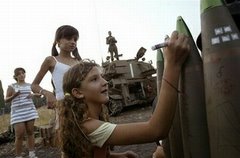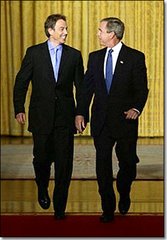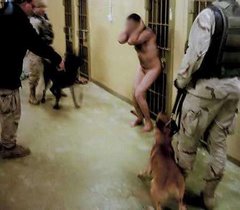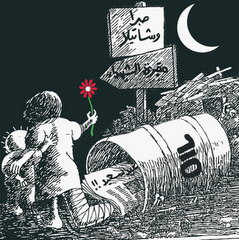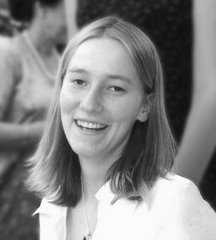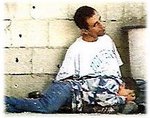
迪莫纳反应堆,从太空. (图片:太空影像/太空旅游特克)
The Dimona Reactor, as seen from space. (Photo: Space Imaging/NTA Space Turk)
Nuclear Weapons --- 核武器The Israeli nuclear weapons program grew out of the conviction that the Holocaust justified any measures Israel took to ensure its survival. Consequently, Israel has been actively investigating the nuclear option from its earliest days. In 1949, HEMED GIMMEL a special unit of the IDF's Science Corps, began a two-year geological survey of the Negev desert with an eye toward the discovery of uranium reserves. Although no significant sources of uranium were found, recoverable amounts were located in phosphate deposits.
The program took another step forward with the creation of the Israel Atomic Energy Commission (IAEC) in 1952. Its chairman, Ernst David Bergmann, had long advocated an Israeli bomb as the best way to ensure "that we shall never again be led as lambs to the slaughter." Bergmann was also head of the Ministry of Defense's Research and Infrastructure Division (known by its Hebrew acronym, EMET), which had taken over the HEMED research centers (HEMED GIMMEL among them, now renamed Machon 4) as part of a reorganization. Under Bergmann, the line between the IAEC and EMET blurred to the point that Machon 4 functioned essentially as the chief laboratory for the IAEC. By 1953, Machon 4 had not only perfected a process for extracting the uranium found in the Negev, but had also developed a new method of producing heavy water, providing Israel with an indigenous capability to produce some of the most important nuclear materials.
For reactor design and construction, Israel sought the assistance of France. Nuclear cooperation between the two nations dates back as far as early 1950's, when construction began on France's 40MWt heavy water reactor and a chemical reprocessing plant at Marcoule. France was a natural partner for Israel and both governments saw an independent nuclear option as a means by which they could maintain a degree of autonomy in the bipolar environment of the cold war.
In the fall of 1956, France agreed to provide Israel with an 18 MWt research reactor. However, the onset of the Suez Crisis a few weeks later changed the situation dramatically. Following Egypt's closure of the Suez Canal in July, France and Britain had agreed with Israel that the latter should provoke a war with Egypt to provide the European nations with the pretext to send in their troops as peacekeepers to occupy and reopen the canal zone. In the wake of the Suez Crisis, the Soviet Union made a thinly veiled threat against the three nations. This episode not only enhanced the Israeli view that an independent nuclear capability was needed to prevent reliance on potentially unreliable allies, but also led to a sense of debt among French leaders that they had failed to fulfill commitments made to a partner. French premier Guy Mollet is even quoted as saying privately that France "owed" the bomb to Israel.
On 3 October 1957, France and Israel signed a revised agreement calling for France to build a 24 MWt reactor (although the cooling systems and waste facilities were designed to handle three times that power) and, in protocols that were not committed to paper, a chemical reprocessing plant. This complex was constructed in secret, and outside the IAEA inspection regime, by French and Israeli technicians at Dimona, in the Negev desert under the leadership of Col. Manes Pratt of the IDF Ordinance Corps.
Both the scale of the project and the secrecy involved made the construction of Dimona a massive undertaking. A new intelligence agency, the Office of Science Liasons, (LEKEM) was created to provide security and intelligence for the project. At the height construction, some 1,500 Israelis some French workers were employed building Dimona. To maintain secrecy, French customs officials were told that the largest of the reactor components, such as the reactor tank, were part of a desalinization plant bound for Latin America. In addition, after buying heavy water from Norway on the condition that it not be transferred to a third country, the French Air Force secretly flew as much as four tons of the substance to Israel.
Trouble arose in May 1960, when France began to pressure Israel to make the project public and to submit to international inspections of the site, threatening to withhold the reactor fuel unless they did. President de Gaulle was concerned that the inevitable scandal following any revelations about French assistance with the project, especially the chemical reprocessing plant, would have negative repercussions for France's international position, already on shaky ground because of its war in Algeria.
At a subsequent meeting with Ben-Gurion, de Gaulle offered to sell Israel fighter aircraft in exchange for stopping work on the reprocessing plant, and came away from the meeting convinced that the matter was closed. It was not. Over the next few months, Israel worked out a compromise. France would supply the uranium and components already placed on order and would not insist on international inspections. In return, Israel would assure France that they had no intention of making atomic weapons, would not reprocess any plutonium, and would reveal the existence of the reactor, which would be completed without French assistance. In reality, not much changed - French contractors finished work on the reactor and reprocessing plant, uranium fuel was delivered and the reactor went critical in 1964.
In a report published on 4 August 2005, the BBC revealed evidence from the British National Archives that showed that the UK sold 20 tons of heavy water to Israel for £1.5 million in 1958. The heavy water, surplus from a shipment purchased by the UK from Norway in 1956, was for use in Israel's Dimona reactor. British officials involved in the deal made a conscious effort to keep the deal secret from both the United States and ministers of their own government. In 1961, Israel asked the UK for more heavy water, but due to the publicity that the Dimona project was receiving at the time, the British declined to sell any more to the Israelis.
The United States first became aware of Dimona's existence after U-2 overflights in 1958 captured the facility's construction, but it was not identified as a nuclear site until two years later. The complex was variously explained as a textile plant, an agricultural station, and a metallurgical research facility, until David Ben-Gurion stated in December 1960 that Dimona complex was a nuclear research center built for "peaceful purposes."
There followed two decades in which the United States, through a combination of benign neglect, erroneous analysis, and successful Israeli deception, failed to discern first the details of Israel's nuclear program. As early as 8 December 1960, the CIA issued a report outlining Dimona's implications for nuclear proliferation, and the CIA station in Tel Aviv had determined by the mid-1960s that the Israeli nuclear weapons program was an established and irreversible fact.
United States inspectors visited Dimona seven times during the 1960s, but they were unable to obtain an accurate picture of the activities carried out there, largely due to tight Israeli control over the timing and agenda of the visits. The Israelis went so far as to install false control room panels and to brick over elevators and hallways that accessed certain areas of the facility. The inspectors were able to report that there was no clear scientific research or civilian nuclear power program justifying such a large reactor - circumstantial evidence of the Israeli bomb program - but found no evidence of "weapons related activities" such as the existence of a plutonium reprocessing plant.
Although the United States government did not encourage or approve of the Israeli nuclear program, it also did nothing to stop it. Walworth Barbour, US ambassador to Israel from 1961-73, the bomb program's crucial years, primarily saw his job as being to insulate the President from facts which might compel him to act on the nuclear issue, alledgedly saying at one point that "The President did not send me there to give him problems. He does not want to be told any bad news." After the 1967 war, Barbour even put a stop to military attachés' intelligence collection efforts around Dimona. Even when Barbour did authorize forwarding information, as he did in 1966 when embassy staff learned that Israel was beginning to put nuclear warheads in missiles, the message seemed to disappear into the bureaucracy and was never acted upon.
In early 1968, the CIA issued a report concluding that Israel had successfully started production of nuclear weapons. This estimate, however, was based on an informal conversation between Carl Duckett, head of the CIA's Office of Science and Technology, and Edward Teller, father of the hydrogen bomb. Teller said that, based on conversations with friends in the Israeli scientific and defense establishment, he had concluded that Israel was capable of building the bomb, and that the CIA should not wait for an Israeli test to make a final assessment because that test would never be carried out.
Posted By www.globalsecurity.org
Read it in Chinese --> 阅读中文
以色列核武计划核武器的前身有理由确信屠杀以色列采取任何措施,以确保其生存. 因此,以色列一直在积极调查其核选择从最早天. 1949年,哈迈德gimmel国防军特种部队的科学兵团 开始两年内盖夫沙漠地质调查与主导权发现铀储量. 虽然没有发现重大的铀源,可采量位于磷酸盐存款. 节目又迈进了一大步,创造了以色列原子能委员会于1952年(原子能). 主席恩斯特幼斯蒂娜 曾长期主张以色列炸弹是最佳的保证",决不再为主导羊羔" 斯蒂娜也是国防部主管科研和基础设施司(希伯来已知其缩写,emet) 已接管哈迈德研究中心(哈迈德gimmel当中 现在改machon4)作为重组. 根据斯蒂娜 emet间的界线模糊,并给伊拉克原子能machon四点基本上为行政运作的原子能实验室. 由1953年4machon不仅完善了工艺提取铀格夫发现, 还研制生产重水的新方法, 向以色列提供原生产能力的一些最重要的核原料. 为反应堆设计和施工,以色列寻求协助法国. 两国核合作据追溯到50年代初, 当法国开始建造的重水反应堆和40mwt化学厂在Marcoule的. 法国是天然的伙伴,两国政府认为,以色列的核选择作为一个独立的方法,使他们能够保持一定程度的自治两极冷战环境. 1956年秋,法国同意向以色列提供18兆瓦研究堆. 然而,苏伊士运河危机爆发几周之后形势急剧变化. 继埃及的苏伊士运河关闭7 法国和英国已同意与以色列挑起战争,后者应提供与埃及同欧洲国家在其部队为借口派遣维和重新占领运河区. 在苏伊士运河危机之后,苏联作了掩饰霸道威胁三国. 这个插曲不仅加强以色列认为独立核能力需要依赖可能是不可靠的盟国,以防止、 而且导致了法国领导人之间的债务意识,他们没有履行自己承诺的一个伙伴. 法国总理家伙mollet甚至话说私下表示,法国"欠"的炸弹给以色列. 关于1957年10月3日, 法国和以色列签署了一项协议,要求法国修改建设24兆瓦反应堆(虽然冷却系统和废物处理设施的设计能力三倍), 在协议中未承诺皮化学厂. 这是在复杂的秘密,国际原子能机构检查制度以外,法国和以色列在迪莫纳技术员、 在盖夫沙漠鬃毛普拉特领导下的国防军上校军团条例. 无论规模和项目建设取得涉及保密迪莫纳浩大. 新情报机构,办事处科学liasons(lekem)创立提供安全和情报的项目. 在施工高峰,约1500名以色列人一些法国建筑工人迪莫纳. 为了保密,法国海关官员表示,最大的反应堆组件 例如反应堆坦克,是一部海水淡化厂运往拉丁美洲. 此外, 在买重水从挪威的情况下,它不会被转移到第三国, 法国空军秘密出动高达4吨的物质到以色列. 1960年5月发生故障, 当法国开始向以色列施加压力,使公共工程和向国际视察现场 扬言中止反应堆的燃料,除非他们这样做的. 戴高乐总统担心难免有爆发的丑闻之后,法国与援助项目 尤其化学厂,将有负面影响,法国的国际地位, 因为它已经动摇地面战争在阿尔及利亚. 在随后与本-古里、 戴高乐售予以色列战斗机对换工作停厂, 来到远离会议确信此事被关闭. 它不是. 在未来几个月,以色列出台了妥协. 法国将与零件供应的铀已经放在秩序和不坚持国际核查. 作为回报,以色列会向法国表示他们无意制造原子武器 没有任何加工钚,并揭示存在反应堆 将未经竣工法国援助. 实际上,没有多少改变法国反应堆工程承包商和成品厂、 铀作燃料的反应堆是在1964年进入关键. 在2005年8月4日发表的一份报告, 证据显示,英国广播公司从英国国家档案显示,卖出20吨重水给以色列为150万英镑1958. 大量用水,剩余由一批从英国购买了挪威在1956年 被用于以色列迪莫纳反应堆. 英国官员参与了这项交易的自觉努力,保持双方的秘密协议,美国和其政府的部长. 1961年,英国要求以色列更多重水, 但由于宣传的迪莫纳项目接收当时 英国拒绝出售更多的以色列人. 美国首次发现迪莫纳生存后的U-2飞越1958被俘设施的建设、 但不列为核现场,直到两年后. 被解释为各种复杂的纺织工厂,一个农业站、冶金研究设施、 直到幼本-古里表示,在1960年12月,是一个复杂的迪莫纳核研究中心的建成,为"和平目的" 随后的二十年中,美国通过多种良性忽视,分析错误, 以色列成功行骗,没有看出第一细节以色列的核计划. 早在1960年12月8日,美国中央情报局发表一份报告,概述迪莫纳的影响核扩散 和中央情报局曾在特拉维夫站由60年代中期,以色列核武计划是既定的和不可逆转的事实. 美国核查人员参观迪莫纳七次六十年 但是他们无法准确了解目前所开展的活动, 由于以色列严格控制访问的时间和议程. 以色列人竟以虚假控制室安装板和砖瓦对电梯或走廊,进入某些领域居. 核查人员可以向各位报告,也没有明确的科学研究或民用核能计画说明这样的大型反应堆旁证了以色列炸弹节目,但发现没有证据表明"武器有关的活动",如存在着钚的工厂. 尽管美国政府不鼓励或批准了以色列的核计划 它也没有什么可以阻止它. walworth钝,从1961年至1973年美国驻以色列的炸弹计划的关键年 主要看他的工作是为了保障总统从事实可能逼其法在核问题上 一度alledgedly说,"总统没有给他送我上的问题. 他不想告诉任何坏消息. " 1967年战争后,连江雪制止武官的情报收集工作迪莫纳左右. 即使没有授权江雪传递信息、 他曾在1966年时为大使馆工作人员介绍,以色列开始把核弹头飞弹 这个信息似乎并没有消失在官僚行事. 1968年初,美国中央情报局发表报告总结说,以色列已成功启动生产核武器. 这项估计,不过,根据一项非正式对话卡尔包皮、 美国中央情报局长办公室科技、承天出纳员、氢弹之父. 柜员说,基于朋友的交谈中,以色列科学和国防建设, 他得出结论说,以色列的轰炸能力建设, 中央情报局和以色列不要等待检验,进行最后评估,因为这不会进行测试.




